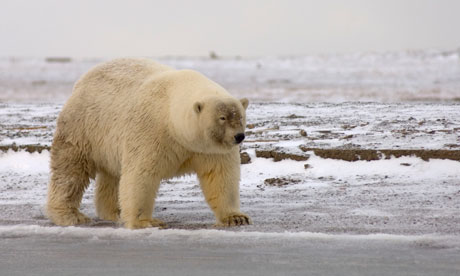TOP STORIES
Thousands of mallards die; traced to eating moldy grain
As many as 7,000 mallards have died in a small pond near Pierre, S.D., the apparent result of the birds ingesting moldy grain from a feedlot.
The congregation of mallards had remained in South Dakota despite severe cold and snow this winter, gathering in a small pond, apparently kept open by an artesian well.
The well can't be easily shut off, according to a U.S. Fish and Wildlife Service memo.
Star Tribune - blog.nwf.org
9 Feb 2011
Photo credit: S.D. Game Fish and Parks Department, Star Tribune
Location: Pierre, Sully County, South Dakota, USA - Map It

Environmental toxins threaten Swedish otters
The number of otters in Sweden has been restored in earnest to over 2,000 over since the 1970s, when PCBs were banned in the country, but new toxins may harm the population's continued growth.
This time around, the otter is in danger of decline through perfluorinated substances, toxic materials that are used in waterproofing and can damage the liver and reproductive system.
"Analyses of 10 different fluorinated substances in otters show a dramatic increase from 1980 to today.
The Local - www.thelocal.se
14 Feb 2011
Photo credit: Neil McIntosh/Flickr (file)
Warming Arctic brings invasion of southern species
. . . Almost lost in the current debate about Arctic hybridization and invasive species from the south is that some southern marine mammals will also bring with them diseases for which Arctic marine mammals have no immunity.
The possibility of this happening came to light several years ago when Canadian scientists were monitoring the spread of trichinella in the Arctic.
This parastic roundworm, which is commonly found in polar bears and Arctic fox, was of little concern in the Arctic until the 1980s, when it began to spread to walrus and to humans who had eaten uncooked walrus meat, as occurred last fall in a village in Nunavut.
Guardian News - www.guardian.co.uk (Source: Yale Environment 360)
14 Feb 2011
E Struzik
Photo credit: Steven Kazlowski/Corbis
Related News
Great Barrier Reef In Jeopardy Following Cyclone
The floodwaters and cyclone have flushed sediment, as well as remnants of fertilizers and pesticides over the coral reef.
The acidic terrestrial washout will leave telltale signs in the corals’ skeletons for years to come.
In the short-term, too much sediment turns the normal nutrients in the water into an unhealthy diet.
Discovery News - news.discovery.com
14 Feb 2011
S Schutzman
Photo credit: NASA MODIS Rapid Response Team
OTHER WILDLIFE HEALTH RELATED NEWS
Photo credit: Carlos Palacín- Success of Male Bustards Is Measured by Their 'Beards'
- Wildlife biologists verify more than 100 bobcat sightings in Ohio
- Butterflies make partial comeback in Mexico
Wildlife Smuggling
- Nearly 1500 turles seized in Bihar [India]
- 200 Animals Smuggled in Suitcases [Thailand]
- DNR says it broke up band of wildlife thrill killers [Wisconsin]
- Endangered whooping crane discovered shot to death - Weiss Lake, Cherokee County, Alabama, USA - Map It










